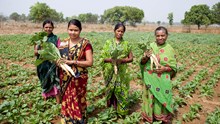
Fig also known as Ficus carica (synonyms – forbidden fruit), cultivation has been in practice since ancient times, and the crop is known for its adaptability, nutritional richness, and diverse uses. In India, the fig is mainly cultivated in Maharashtra, Gujarat, Tamil Nadu, and Uttar Pradesh, meeting domestic and export demands. The fig's unique 'syconium' structure and its ability to produce fruit either parthenocarpically or by pollination through the wasp Blastophaga make it an interesting crop to cultivate. Fig farming represents a potential revenue source for farmers as the increasing demand from consumers ends due to the health consciousness and natural products.
Specific Feature of Figs
Figs are medium-sized deciduous trees in subtropical regions and remain evergreen in tropical climates. The trees have irregular branches, broad ovate leaves, and long-stalked fruits. The fruit, botanically called a 'syconium,' is pear-shaped with velvety or smooth skin, usually purple or black. The syconium consists of a hollow structure with tiny, true fruits lining its inner surface.
Regional Adaptation
Figs tolerate dryness and salinity well and grow well in temperate and subtropical regions. They grow well on loamy soils with good drainage properties and have a pH of 6.0 to 8.0. The high temperatures during fruiting improve quality and sweetness so the areas with hot summers and moderate winters are optimal. The western Indian states—Maharashtra and Gujarat in particular—are ideal for fig cultivation due to their arid climate. Fig trees also adapt to marginal lands, making them suitable for regions with poor soil fertility.
Figs Use and Health Benefits
Figs are very nutrient-dense with a unique combination of high sugar and low acid content. Calorie-rich, protein-rich, calcium-rich, even more so than milk, iron-rich, and fiber-rich, figs rank as one of the most healthy fruits around. Fresh, dried, or canned, It is available for every taste, texture, and purpose. Dried figs, with a nutritional index of 11, beat out many of the more commonly consumed fruits such as apples and raisins.
Figs are versatile. Latex of the unripe fruit or any part of the tree is applied to curdle milk for cheese and drinks and has other more traditional uses as a medicinal product, used in the treatment of skin ulcers, sores, and digestive disorders. Fig leaves are used as animal fodder and for perfume extracts like "fig-leaf absolute." Folk remedies also recommend figs to soothe sore throats, swollen gums, and tumors, and for their laxative action. This combination of health and utility makes figs invaluable in both culinary and therapeutic contexts.
Varieties and Which You Should Choose
Globally, over 700 varieties of figs exist, categorized based on color and pollination patterns. In India, the Poona fig is widely cultivated for its medium size, sweet flavor, and good processing quality. Other prominent varieties include:
-
Adriatic: Known for its greenish-yellow skin and superior sweetness, suitable for fresh consumption and processing.
-
Black Schia: A high-quality variety with dark skin and rich flavor, suitable for export markets.
-
Brown Turkey: Popular for its large fruit size and adaptability to diverse climates.
In comparative trials, California hybrids have shown promise in terms of higher yield and better fruit quality, outperforming traditional Poona figs in some regions.
The Poona fig is one of the most popular fig varieties in India, known for its bell-shaped, medium-sized fruits that weigh around 42 grams. It has a thin skin with a light-purple hue and red flesh, offering a sweet and delightful flavor. Some fig hybrids from California have performed well in Indian conditions, producing parthenocarpic fruits. Commonly grown varieties in India include Adriatic, Black Schia, Brown Turkey, Turkish White, Kabul, Marseilles, and Lucknow figs. The Coimbatore fig, a type of Adriatic fig, is regarded as superior to the Poona fig.
Economic and Market Value
Figs are a valuable crop for both fresh and processed markets. Fresh figs are sold at premium prices and do require careful handling and quick transportation due to their perishability. Dried figs have a longer shelf life and it dominate export markets. In India, fresh figs sell for Rs 50–100 per kilogram in local markets, while dried figs command Rs 800–Rs 1,200 per kilogram in both the national and international markets. A single fig tree can yield 180–360 fruits annually, thus generating a steady income source for farmers. Proper post-harvesting techniques such as cold storage and modified atmosphere packaging of fresh figs can significantly extend the marketability of the fruits.
With its nutritional worth, variety of uses, and financial advantages, fig cultivation presents Indian farmers with a viable and lucrative business opportunity. Figs can significantly enhance rural incomes and contribute to agricultural diversification with the right varietal selection, better farming methods, and well-placed market connections.
















